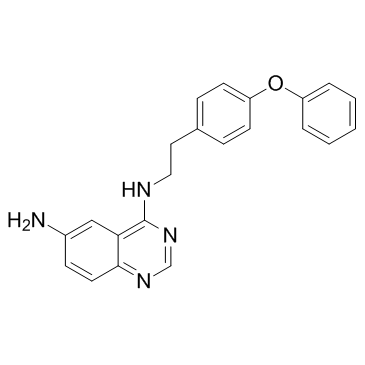545380-34-5
| Name | 4-N-[2-(4-phenoxyphenyl)ethyl]quinazoline-4,6-diamine |
|---|---|
| Synonyms |
N-[2-(4-Phenoxyphenyl)ethyl]-4,6-quinazolinediamine
6-Amino-4-(4-phenoxyphenylethylamino)quinazoline 4,6-quinazolinediamine, N-[2-(4-phenoxyphenyl)ethyl]- N-[2-(4-Phenoxyphenyl)ethyl]quinazoline-4,6-diamine QNZ NF-kappaB Activation Inhibitor N4-[2-(4-Phenoxyphenyl)ethyl]-4,6-quinazolinediamine EVP4593 |
| Description | QNZ shows strong inhibitory effects on NF-κB transcriptional activation and TNF-α production with IC50s of 11 and 7 nM, respectively. EVP4593 is a neuroprotective inhibitor of SOC channel. |
|---|---|
| Related Catalog | |
| Target |
NF-κB:11 nM (IC50, in human Jurkat cells transfected with pNFκB-Luc) TNF-α:7 nM (IC50, in murine splenocytes stimulated with LPS) |
| In Vitro | QNZ (Compound 11q) has a suppressing effect of the NF-κB mediated-inflammatory response. QNZ inhibits edema formation dose-dependently[1]. QNZ (EVP4593) reduces the number of lysosomes/autophagosomes and store-operated channel (SOC) currents in Huntington's disease (HD). Normalization of calcium transport within neurons in response to QNZ is expect to reduce pathology manifestation. A number of lysosomes/autophagosomes are evaluated in HD and WT neurons treated with QNZ using transmission electron microscopy (TEM). Incubation with QNZ reduces the number of lysosomes/autophagosomes in HD GABAergic medium spiny (GABA MS)-like neurons (GMSLNs) by almost two-fold (from 0.41±0.04 to 0.23±0.04; p<0.05), while WT neurons are not affected. This observation is confirmed by examining lysosome content by flow cytometry (FC) analysis. The median fluorescence intensity is reduced by 34±6 % in HD GMSLNs upon QNZ treatment (p<0.05)[2]. |
| Cell Assay | iPSHD22 cells are cultured in K-4 medium in a 96-well black plates with clear flat bottom. Next, cells are treated with chemical compounds (e.g., QNZ 100 nM) for 24 h prior to analysis. Fluorescent assay MultiTox-Fluor Multiplex Cytotoxicity Assay is used to measure simultaneously the relative number of live (viability) and dead (cytotoxicity) cells in each well. Fluorescence is detected by DTX 880 Multimode Microplate Reader. To evaluate the level of cell death (LoCD), the following equation is employed: ([cytotoxicity in a well with cells]-[cytotoxicity in a well without cells])/([viability in a well with cells]-[viability in a well without cells])[2]. |
| References |
| Density | 1.3±0.1 g/cm3 |
|---|---|
| Boiling Point | 602.0±55.0 °C at 760 mmHg |
| Melting Point | 169-175ºC |
| Molecular Formula | C22H20N4O |
| Molecular Weight | 356.420 |
| Flash Point | 317.9±31.5 °C |
| Exact Mass | 356.163696 |
| PSA | 73.06000 |
| LogP | 4.57 |
| Vapour Pressure | 0.0±1.7 mmHg at 25°C |
| Index of Refraction | 1.714 |
| Storage condition | Refrigerator, Under Inert Atmosphere |
| Water Solubility | DMSO: soluble15mg/mL, clear |
| RIDADR | NONH for all modes of transport |
|---|---|
| HS Code | 2933990090 |
| HS Code | 2933990090 |
|---|---|
| Summary | 2933990090. heterocyclic compounds with nitrogen hetero-atom(s) only. VAT:17.0%. Tax rebate rate:13.0%. . MFN tariff:6.5%. General tariff:20.0% |
